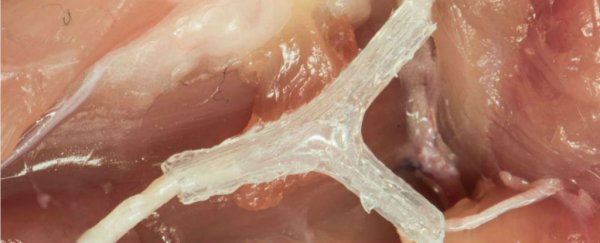You might be ready to write-off 3D printing as one of those technologies that never really lived up to the initial hype, but it's beginning to prove its usefulness in a host of medical treatments, with researchers in the US developing 3D-printed scaffolds that can encourage damaged nerve cells to grow back.
The team started out by designing their 3D scaffolds in shapes that the original nerves were laid out in, so they could act as pathways or 'signposts' for both the sensory and motor functions of complex nerves to grow back through. The scaffolds themselves are made of custom silicone and implanted with biochemical cues to help encourage growth.
So far, the process has only been tested in rats, but signs of improvement in the animals' walking abilities were noticed after 10-12 weeks. "This represents an important proof of concept of the 3D-printing of custom nerve guides for the regeneration of complex nerve injuries," lead researcher Michael McAlpine of the University of Minnesota said in a press release. "Someday we hope that we could have a 3D scanner and printer right at the hospital to create custom nerve guides right on site to restore nerve function."
Now the researchers are hoping humans can benefit from the same approach. Our nerves are notoriously reluctant to grow back after injury, and only repair themselves very slowly, if at all. Nerve grafts, which are complicated and painful, and nerve guidance channels, which use natural materials but can only direct nerves in a straight line, have previously been used, but 3D-printed scaffolds are potentially a much better option - they encourage natural nerve growth and can grow in any shape required.
Using a structured light 3D scanner, the scientists were able to create copies of the layout of the nerves inside the body and then build scaffolds accordingly. These scaffolds then linked two ends of regenerating nerves together, bridging the gap between them. Each branch of the object can have a different chemical make-up, if required. The scanning and printing process takes about an hour.
For now, it's more of a promising concept rather than a reality, but there's hope that further studies can build on this initial success. The researchers were able to get human nerves to hold up reasonably well inside the scaffolds after a period of several weeks, but only in a petri dish rather than an actual body. Details of the study have now been published in the journal Advanced Functional Materials.
